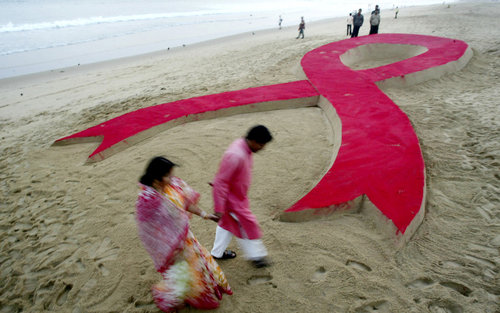
S.Lanka sets target to be HIV free. Here’s a look at what India is doing
Timely interventions are being made by Sri Lanka to end the AIDS epidemic by 2030. These efforts come as part of the Sustainable Development Goals of the UN.
The UN Population Fund(UNFPA) has said that it supported the country’s efforts to implement a five year National Condom Strategy 2016-2020. This because a correct and consistent use of condom is one of the most effective ways of preventing sexual transmission of the disease.
The UNFPA also said that it supported Sri Lanka’s National STD/AIDS Control Programme(NSACP). With the programme, HIV/AIDS guides will be developed for Primary Health Care Workers and those working in condom programming. The objective is to equip the officials with the necessary knowledge and skill . This will help them raise awareness of condom use in different communities.
Alain Sibenaler, the UNFPA Country Representative for Sri Lanka and the Maldives said”I am happy to note that the Sri Lankan government has engaged closely with UNFPA from the start of the journey in ensuring a Comprehensive Condom Programming is carried out in Sri Lanka.”
The global fund recently said that compared to other South Asian countries, Sri Lanka has recorded a drop in HIV/AIDS prevalence.
The country’s National STD Eradication Unit has asserted that the majority of those affected with HIV/AIDS were between the ages of 25 and 45 years.
Meanwhile in India…
Meanwhile in India, no target date has been set per se for eradicating the disease. As per the most recent studies, India reported 1.96 lakh new HIV infections in 2015. This is in addition to the 28.81 lakh people who are already living with the disease.
In India, the National AIDS Control Organization(NACO) is responsible for formulating policy and implementing programs for prevention and control of HIV epidemic.
The current program formulated by the body-called National AIDS Control Program IV or NACP-IV(2012- 2017) aims at bringing down the annual rate of new HIV infections by 50%. This is hoped to be achieved through methods such as comprehensive HIV treatment, education, care and support for people and also targeted interventions for those with a high risk of HIV transmission.
Targeted intervention
In fact, targeted intervention is considered as one of the key components of NACP-IV. It’s hoped that through such interventions, 80% coverage of key affected groups is possible. This would help reduce transmission among high-prone communities(like from sex workers to their male clients etc.)
Education and awareness
As for HIV education and awareness measures, there is the Link Worker Scheme by which information resources are provided on HIV and STI prevention, condom promotion and distribution, HTC and also referral to treatment. Then, there’s the Red Ribbon Express- an awareness campaign train run by the Indian Railways, the train was launched in 2007. Another component is the Condom Social Marketing Programme(CSMP) which is exactly what the name says-promote safe sex by improving the availability of condoms and also using multimedia to encourage a change of behavior.
Harm reduction
As for harm reduction, under the NACP-IV, it’s delivered in the nation through multiple means including opoid susbstitution therapy(OST), needle and syringe programmes(NSPs) and peer education in different healthcare settings. Typically, these interventions are delivered by NGOs though they are supported by the government.
To prevent mother-to-child transmission of disease
To prevent mother-to-child disease transmission, the Prevention of Parent to Child Transmission of HIV/AIDS(PPTCT) programme was started in 2002. It’s estimated that there are more than 15,000 sites in the country that offer PPTCT services. The program aims to initiate antiretroviral treatment for all pregnant as well as breastfeeding women with HIV, regardless of the CD4 count or the stage of HIV infection.
While the different measures by the government in our fight against HIV is no doubt useful, the lack of a target to eliminate the epidemic points to a lack of serious enthusiasm in eliminating the disease from the nation. With both the physical damages and the social discrimination that the disease entail for a person, the government would do good to do everything under its power to put an end to the epidemic at the earliest.
Image credits: thebetterindia.com